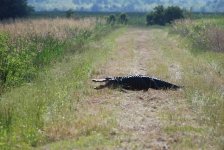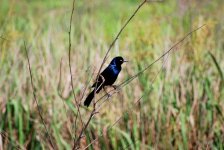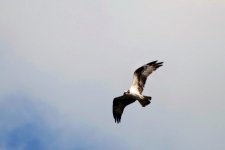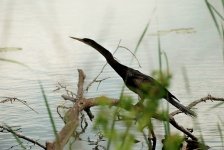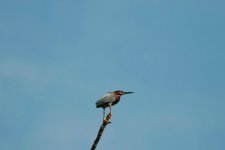TwoDipsfromAmsterdam
Anything About?
This was a family trip to Savannah (Georgia) for a wedding but some decent birding was had in between the necessary family duties. We flew Delta from Paris CDG changing at Atlanta and picked up a hire car at Savannah Airport. We stayed at the Ballastone Inn in the centre of the historic downtown area; expensive but excellent. I have done some birding in the US before but this was the most serious effort so far. I used Sibley’s Eastern Field Guide and I think I got everything right although inevitably there was some head-scratching with some species and recognising birds by call and song was pretty much out of the question.
The weather was warm and sunny throughout. I saw about 25 lifers – they’re marked in red.
Day 1 – 29 April.
A Common Grackle at Atlanta Airport opened the scoring, in fact several Common Grackles as we taxied to take off. Driving into Savannah from the Airport produced a Great Egret (I think they breed in the marshes close to the airport) and then the first lifer – a large bird that looked sort of harrier-like but Northern Harrier would be very late down in the south. As we got nearer it looked more cormorant-ish – Anhinga. Good start. I was to see plenty of these oddballs over the next few days and was intrigued by their habit of “landing” on the water and going straight under as if they weren’t able to swim! A Black Vulture was also seen on the way. Having been travelling for the best part of 18 hours we walked from the hotel to a restaurant and added American Robin, House Sparrow and Chimney Swift.
Day 2- 30 April
A touch of jetlag meant I was up at 06:00 and a quick walk around some of the squares was called for. These squares are a feature of Savannah and if you’ve seen the film “Forrest Gump” you might recall Tom Hanks telling his story to anyone who cared to listen with one of the squares immediately behind him. Some Hollywood licence here – all the seats in the squares face into the square whereas Hanks was sitting on a bench facing outwards. That should be good enough for Pedant’s Corner in Private Eye. Anyway, the couple of hours added Starling (great), Northern Mockingbird, Mourning Dove, Brown Thrasher, American Crow, Wood Thrush (an unexpected surprise and feeding young) and a beautiful Red-bellied Woodpecker on a tree right next to where I was sat (facing into the square).
Some internet research suggested that Savannah Wildlife Refuge might be worth a look so I drove out after breakfast. It’s about 7 or 8 miles to the north of the city centre and comprises mainly marshland with plenty of open water and reed beds. A 4-mile gravel road winds around the refuge and is easily driveable with plenty of places to stop and wander off. A Summer Tanager was the first new bird followed by Red-winged Blackbird – of which there seemed to be many breeding in the area. Walking along the raised ground between two stretches of water I noticed movement ahead – an American Alligator walked across the path only 50 yards in front of me – must have been a good 10 feet long. I saw plenty of these magnificent animals over the next few days.
A few Northern Rough-winged Swallows passed over as I was watching Boat-tailed Grackles flying around. A small flock of Glossy Ibis also passed over as I was scanning some Anhingas in a tree. One looked distinctly unusual and turned out to be an Osprey! As the morning wore on I saw another two or three Ospreys and there always seemed to be at least one in the air. A snipe flushed from some reeds immediately below the track was a Wilson’s Snipe – quite late and unexpected at the end of April. A Moorhen was a particularly unexciting find – there were plenty around. More interesting was a flock of several birds that flew in and landed on the grassy bank of the dike. Their yellow napes contrasting with black faces gave them away as Bobolink. A couple of Least Terns flew around and a Fish Crow drifted over giving itself away by high-pitched call. A Great Blue Heron was found in a ditch and a single American Coot was pootling around on a stretch of open water. A distant raptor had me wondering but not for long as its wing patches meant Mississippi Kite. Very agile birds and quite different from Black or Red Kites in Europe. The inevitable Red-tailed Hawk arrived and drifted around before leaving. Green Heron and Snowy Egret were both added before long. The raptor list grew with a couple of Turkey Vultures over. A Little Blue Heron kept the numbers ticking over and a small area of woodland produced a noisy Carolina Wren, plus Blue Jay, Carolina Chickadee and Northern Cardinal. I completed the 4 mile tour and returned to the start. Realising there was a complete absence of warblers (although I had probably missed some through being unable to identify song), I hung around the pine trees at the entrance and was rewarded with, appropriately enough, a Pine Warbler. Crossing the road to look at some more wet areas I found several White Ibis and a Black Vulture overhead concluded the visit.
Day 3 – 1 May
The final day before family responsibilities would curtail any lengthy birding. I drove south of Savannah for about 40 miles to Harris Neck Refuge. En route I added Barn Swallow to the list. I managed to overshoot the entrance to the reserve and in turning to get back I reversed into a space and my eye caught something quite colourful in the bushes – Painted Bunting! This was the target bird for Harris Neck and I hadn’t even switched the engine off let alone got out of the car! The only downside was that the view was relatively brief as it didn’t hang around. The other target bird was Wood Stork and that was the second bird seen! There were plenty of these around so much less of a challenge than the bunting. Like Savannah there is a driveable trail of about 4 miles so it was relatively easy to cover the area.
Many of the birds seen the previous day were also present here so they’re not listed. Wandering off into some thick woodland a small bird flew into some bushes and provided a real challenge to see it let alone identify it. Patience was rewarded when it revealed itself as a cracking little Blue-Gray Gnatcatcher – a welcome sight especially as there were plenty of gnats and other annoying insects around. Fortunately a can of “Off” was quite effective. A Cattle Egret was found in a clearing that contained some open water (and more alligators). I drove a little bit further to Woody Pond and walked up onto the embankment that overlooks an amazing sight. Open water with plenty of islands with trees and each tree seemed to hold at least one nest of an egret or heron although a Scarlet Tanager was the first new bird seen in the wooded surrounds. A Tri-coloured Heron was a real treat – they seemed plentiful here. I got talking to some locals (well not that local – they were from Atlanta). I was hoping they might be able to help out with some calls and songs but in the end I think I knew the birds here better than they did! They were delighted when I pointed out an Osprey and a small orange-flanked flycatchery looking thing that was prominent by the water’s edge – a female Eastern Bluebird. A Double-crested Cormorant was a welcome change from all the Anhingas.
I drove on around the trail and came to the runway of the disused aerodrome that was here in WWII. This was a great contrast in habitat as it was dry and scrubby and a possible spot for another Painted Bunting. Walking along the path a large bird (that wasn’t a stork, egret or heron) caught my eye in the distance. As it came closer it was clearly an immature Bald Eagle, always a great find. A blue bird flew across the track and hid in some bushes before giving itself up as an Indigo Bunting – seeing blue birds like this is something special for us Europeans (no, a Blue Tit isn’t THAT blue). Something was rustling away in the undergrowth and this being the US it was not going to be a Blackbird. It eventually revealed itself and the white wing spots, orangey flanks and black upperparts proved to be an Eastern Towhee. Sadly no Painted Bunting but I did find another Pine Warbler on the way out, along with a Common Ground Dove.
Harris Neck is unmissable if you’re ever this way. I liked the contrast between dry and wet areas – something that was less obvious at the Savannah reserve.
Returning to Savannah I found I had some time to spare so I went for a walk along the riverfront. Very touristy but attractive nevertheless. It produced Ring-billed Gull and Laughing Gull in addition to more common birds already seen.
Day 4 – 2 May
This was the day of the wedding so not much time available. An early morning walk to Forsyth Park in downtown was interesting as I found a Blackpoll Warbler and a Java Sparrow. The warbler was singing high up in the trees and took ages to reveal itself. No doubt anyone familiar with the song would have identified it immediately. The Java Sparrow was interesting. According to Sibley it’s an escapee normally found in Florida and does not seem to have established a breeding population. Savannah is only a couple of hundred miles north of Florida so the questions I would like to ask of anyone better placed than I, is – are they now established as breeding and are they found north of Florida?
In between preparations for the evening wedding I sneaked in a mid-afternoon walk by the river and came up with a Royal Tern!
The wedding was held in a private garden in Savannah. At a particularly significant part of the ceremony (exchanging vows I think) I pointed out to Mrs DiP a Cardinal in some bushes just behind the bride. I received a rather unpleasant kick in the ankle as a result. So I said nothing when a Blue Jay landed on the fence.
Day 5 – 3 May
More family events limited time so I went back to Savannah Wildlife Refuge in the morning. As I drove in a pair of Killdeer appeared in the first ditch – I had been hoping to see them at Savannah Airport but they were absent unlike last year when I visited (a non-birding trip on that occasion). An Eastern Kingbird was also a good find – last year I had found a pair by the Marriot Hotel on the riverfront but they weren’t seen there this year. A Tufted Titmouse was the only other new bird seen although 2 Mississippi Kites were doing some spectacular hawking after dragonflies, reminding me of our Hobbies back in Europe. The rest of the day was given up to family engagements.
Day 6 – 4 May
Our flight was due out of Savannah at 15:25 so I had a last look at Forsyth Park in the morning. The Blackpoll Warbler was still present – in the same tree but a greater find was a Black-throated Blue Warbler close by. A House Finch just outside the Park rounded off the trip.
We arrived back at Paris CDG at 11:00 on 5 May and a Kestrel and some Swifts were a welcome sight (whereas the usual CDG Carrion Crows are not).
A very enjoyable trip and obviously many more species could have been had with better id skills of American birds and, of course, more time. I’m still fretting over a possible Louisiana Waterthrush at Savannah WR but I can’t be sure so it’s not countable.
I would welcome any comments or questions that members might have. Especially welcome answers to my questions about the Java Sparrow.
The weather was warm and sunny throughout. I saw about 25 lifers – they’re marked in red.
Day 1 – 29 April.
A Common Grackle at Atlanta Airport opened the scoring, in fact several Common Grackles as we taxied to take off. Driving into Savannah from the Airport produced a Great Egret (I think they breed in the marshes close to the airport) and then the first lifer – a large bird that looked sort of harrier-like but Northern Harrier would be very late down in the south. As we got nearer it looked more cormorant-ish – Anhinga. Good start. I was to see plenty of these oddballs over the next few days and was intrigued by their habit of “landing” on the water and going straight under as if they weren’t able to swim! A Black Vulture was also seen on the way. Having been travelling for the best part of 18 hours we walked from the hotel to a restaurant and added American Robin, House Sparrow and Chimney Swift.
Day 2- 30 April
A touch of jetlag meant I was up at 06:00 and a quick walk around some of the squares was called for. These squares are a feature of Savannah and if you’ve seen the film “Forrest Gump” you might recall Tom Hanks telling his story to anyone who cared to listen with one of the squares immediately behind him. Some Hollywood licence here – all the seats in the squares face into the square whereas Hanks was sitting on a bench facing outwards. That should be good enough for Pedant’s Corner in Private Eye. Anyway, the couple of hours added Starling (great), Northern Mockingbird, Mourning Dove, Brown Thrasher, American Crow, Wood Thrush (an unexpected surprise and feeding young) and a beautiful Red-bellied Woodpecker on a tree right next to where I was sat (facing into the square).
Some internet research suggested that Savannah Wildlife Refuge might be worth a look so I drove out after breakfast. It’s about 7 or 8 miles to the north of the city centre and comprises mainly marshland with plenty of open water and reed beds. A 4-mile gravel road winds around the refuge and is easily driveable with plenty of places to stop and wander off. A Summer Tanager was the first new bird followed by Red-winged Blackbird – of which there seemed to be many breeding in the area. Walking along the raised ground between two stretches of water I noticed movement ahead – an American Alligator walked across the path only 50 yards in front of me – must have been a good 10 feet long. I saw plenty of these magnificent animals over the next few days.
A few Northern Rough-winged Swallows passed over as I was watching Boat-tailed Grackles flying around. A small flock of Glossy Ibis also passed over as I was scanning some Anhingas in a tree. One looked distinctly unusual and turned out to be an Osprey! As the morning wore on I saw another two or three Ospreys and there always seemed to be at least one in the air. A snipe flushed from some reeds immediately below the track was a Wilson’s Snipe – quite late and unexpected at the end of April. A Moorhen was a particularly unexciting find – there were plenty around. More interesting was a flock of several birds that flew in and landed on the grassy bank of the dike. Their yellow napes contrasting with black faces gave them away as Bobolink. A couple of Least Terns flew around and a Fish Crow drifted over giving itself away by high-pitched call. A Great Blue Heron was found in a ditch and a single American Coot was pootling around on a stretch of open water. A distant raptor had me wondering but not for long as its wing patches meant Mississippi Kite. Very agile birds and quite different from Black or Red Kites in Europe. The inevitable Red-tailed Hawk arrived and drifted around before leaving. Green Heron and Snowy Egret were both added before long. The raptor list grew with a couple of Turkey Vultures over. A Little Blue Heron kept the numbers ticking over and a small area of woodland produced a noisy Carolina Wren, plus Blue Jay, Carolina Chickadee and Northern Cardinal. I completed the 4 mile tour and returned to the start. Realising there was a complete absence of warblers (although I had probably missed some through being unable to identify song), I hung around the pine trees at the entrance and was rewarded with, appropriately enough, a Pine Warbler. Crossing the road to look at some more wet areas I found several White Ibis and a Black Vulture overhead concluded the visit.
Day 3 – 1 May
The final day before family responsibilities would curtail any lengthy birding. I drove south of Savannah for about 40 miles to Harris Neck Refuge. En route I added Barn Swallow to the list. I managed to overshoot the entrance to the reserve and in turning to get back I reversed into a space and my eye caught something quite colourful in the bushes – Painted Bunting! This was the target bird for Harris Neck and I hadn’t even switched the engine off let alone got out of the car! The only downside was that the view was relatively brief as it didn’t hang around. The other target bird was Wood Stork and that was the second bird seen! There were plenty of these around so much less of a challenge than the bunting. Like Savannah there is a driveable trail of about 4 miles so it was relatively easy to cover the area.
Many of the birds seen the previous day were also present here so they’re not listed. Wandering off into some thick woodland a small bird flew into some bushes and provided a real challenge to see it let alone identify it. Patience was rewarded when it revealed itself as a cracking little Blue-Gray Gnatcatcher – a welcome sight especially as there were plenty of gnats and other annoying insects around. Fortunately a can of “Off” was quite effective. A Cattle Egret was found in a clearing that contained some open water (and more alligators). I drove a little bit further to Woody Pond and walked up onto the embankment that overlooks an amazing sight. Open water with plenty of islands with trees and each tree seemed to hold at least one nest of an egret or heron although a Scarlet Tanager was the first new bird seen in the wooded surrounds. A Tri-coloured Heron was a real treat – they seemed plentiful here. I got talking to some locals (well not that local – they were from Atlanta). I was hoping they might be able to help out with some calls and songs but in the end I think I knew the birds here better than they did! They were delighted when I pointed out an Osprey and a small orange-flanked flycatchery looking thing that was prominent by the water’s edge – a female Eastern Bluebird. A Double-crested Cormorant was a welcome change from all the Anhingas.
I drove on around the trail and came to the runway of the disused aerodrome that was here in WWII. This was a great contrast in habitat as it was dry and scrubby and a possible spot for another Painted Bunting. Walking along the path a large bird (that wasn’t a stork, egret or heron) caught my eye in the distance. As it came closer it was clearly an immature Bald Eagle, always a great find. A blue bird flew across the track and hid in some bushes before giving itself up as an Indigo Bunting – seeing blue birds like this is something special for us Europeans (no, a Blue Tit isn’t THAT blue). Something was rustling away in the undergrowth and this being the US it was not going to be a Blackbird. It eventually revealed itself and the white wing spots, orangey flanks and black upperparts proved to be an Eastern Towhee. Sadly no Painted Bunting but I did find another Pine Warbler on the way out, along with a Common Ground Dove.
Harris Neck is unmissable if you’re ever this way. I liked the contrast between dry and wet areas – something that was less obvious at the Savannah reserve.
Returning to Savannah I found I had some time to spare so I went for a walk along the riverfront. Very touristy but attractive nevertheless. It produced Ring-billed Gull and Laughing Gull in addition to more common birds already seen.
Day 4 – 2 May
This was the day of the wedding so not much time available. An early morning walk to Forsyth Park in downtown was interesting as I found a Blackpoll Warbler and a Java Sparrow. The warbler was singing high up in the trees and took ages to reveal itself. No doubt anyone familiar with the song would have identified it immediately. The Java Sparrow was interesting. According to Sibley it’s an escapee normally found in Florida and does not seem to have established a breeding population. Savannah is only a couple of hundred miles north of Florida so the questions I would like to ask of anyone better placed than I, is – are they now established as breeding and are they found north of Florida?
In between preparations for the evening wedding I sneaked in a mid-afternoon walk by the river and came up with a Royal Tern!
The wedding was held in a private garden in Savannah. At a particularly significant part of the ceremony (exchanging vows I think) I pointed out to Mrs DiP a Cardinal in some bushes just behind the bride. I received a rather unpleasant kick in the ankle as a result. So I said nothing when a Blue Jay landed on the fence.
Day 5 – 3 May
More family events limited time so I went back to Savannah Wildlife Refuge in the morning. As I drove in a pair of Killdeer appeared in the first ditch – I had been hoping to see them at Savannah Airport but they were absent unlike last year when I visited (a non-birding trip on that occasion). An Eastern Kingbird was also a good find – last year I had found a pair by the Marriot Hotel on the riverfront but they weren’t seen there this year. A Tufted Titmouse was the only other new bird seen although 2 Mississippi Kites were doing some spectacular hawking after dragonflies, reminding me of our Hobbies back in Europe. The rest of the day was given up to family engagements.
Day 6 – 4 May
Our flight was due out of Savannah at 15:25 so I had a last look at Forsyth Park in the morning. The Blackpoll Warbler was still present – in the same tree but a greater find was a Black-throated Blue Warbler close by. A House Finch just outside the Park rounded off the trip.
We arrived back at Paris CDG at 11:00 on 5 May and a Kestrel and some Swifts were a welcome sight (whereas the usual CDG Carrion Crows are not).
A very enjoyable trip and obviously many more species could have been had with better id skills of American birds and, of course, more time. I’m still fretting over a possible Louisiana Waterthrush at Savannah WR but I can’t be sure so it’s not countable.
I would welcome any comments or questions that members might have. Especially welcome answers to my questions about the Java Sparrow.
Last edited:




